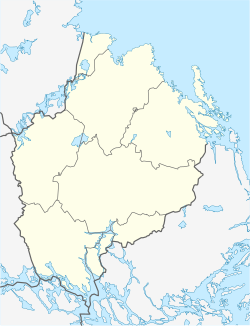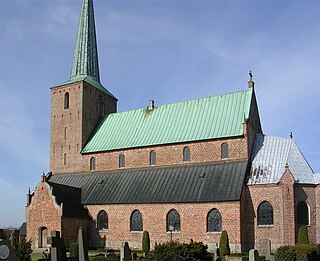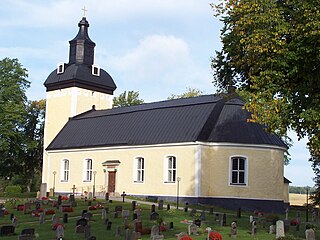| Björklinge | |
|---|---|
 Björklinge church | |
| Coordinates: 60°02′N17°33′E / 60.033°N 17.550°E Coordinates: 60°02′N17°33′E / 60.033°N 17.550°E | |
| Country | Sweden |
| Province | Uppland |
| County | Uppsala County |
| Municipality | Uppsala Municipality |
| Area [1] | |
| • Total | 2.70 km2 (1.04 sq mi) |
| Population (31 December 2010) [1] | |
| • Total | 3,269 |
| • Density | 1,209/km2 (3,130/sq mi) |
| Time zone | UTC+1 (CET) |
| • Summer (DST) | UTC+2 (CEST) |
Björklinge is a locality situated in Uppsala Municipality, Uppsala County, Sweden with 3,269 inhabitants in 2010. [1] The name, written as Birklinge, was used for the parish as early as 1314, and Norsemen graves have been found in the area.
An urban area or tätort in Sweden has a minimum of 200 inhabitants and may be a city, town or larger village. It is a purely statistical concept, not defined by any municipal or county boundaries. Urban areas referred to as cities or towns for statistical purposes have a minimum of 10,000 inhabitants. In 2010, there were 1,956 urban areas in Sweden, covering 85% of the Swedish population.

Uppsala Municipality is a municipality in Uppsala County in east central Sweden. Uppsala has a population of 211,411 (2016-06-30). Its seat is located in the university city of Uppsala.

Uppsala County is a county or län on the eastern coast of Sweden, whose capital is the city of Uppsala. It borders the counties of Dalarna, Stockholm, Södermanland, Västmanland, Gävleborg, and the Baltic Sea.
Björklinge is situated on a glacial ridge next to lake Långsjön. European route E4 passed through the village until the new motorway east of Björklinge was opened for traffic on October 17, 2007.

European route E 4 passes from north to south through Sweden from the border with Finland, with a total length of 1,590 kilometres (990 mi). The Finnish part lies entirely within Tornio in northern Finland, and is only 1 kilometre (0.62 mi) long. The Swedish part traverses most of Sweden except the extreme north and the west coast region, and is commonly considered the highway backbone of Sweden, since it passes in the vicinity of many of its largest cities and through the capital Stockholm. In particular, it is the mainline road used by most vehicle traffic, both personal cars and freight trailers, between the north (Norrland) and southern Sweden or beyond.
Björklinge church, which was first built in the early 14th century and re-built in the 17th century, is in the centre of the village.
The spelman Anders Ljungqvist, called "Gås-Anders" (Anders of the geese), lived in Björklinge most of his life. There is a statue of him, created by the artist Bror Hjorth, standing next to the church. Bror Hjorth had a summer cottage by Långsjön.
Traditional Nordic dance music is a type of traditional music or folk music that once was common in the mainland part of the Nordic countries — Scandinavia plus Finland. The person who plays this kind of music might be called speleman (Swedish/Norwegian), spelman (Swedish), spel(l)emann (Norwegian), pelimanni (Finnish) or spillemand (Danish). Finnish traditional dance music is often called pelimanni music in English, while there does not seem to exist a similar, widespread term for the corresponding music from the other countries. It is often more meaningful to distinguish between the traditional dance music from different regions than between music from the countries as such. Some concepts in the field can be defined as Norwegian or Finnish, but most are either common to all four countries or local. Besides the dance music tradition, all countries also have other traditions of folk music that are not shared to a similar extent.

Anders Ljungqvist, also known as "Gås-Anders", was a Swedish fiddler from Björklinge in Uppland. Gås-Anders got his derogatory nickname as a child when he worked as a goose herder at a mansion house in Gamla Uppsala. As he grew up he never used the name Gås-Anders, and it was not until the 1920s that folk musicians started referring to him by that name, which was by now used as a positive epithet rather than a slur.

Bror Hjorth was a Swedish artist. Hjorth was one of Sweden’s best-known sculptors and painters, and was professor of art at the Royal University College of Fine Arts in Stockholm from 1949 to 1959. On completion of his studies, he lived in Uppsala, where he built his studio home in Kåbo, now the Bror Hjorths Hus museum. He was awarded the Sergel Prize in 1955.















